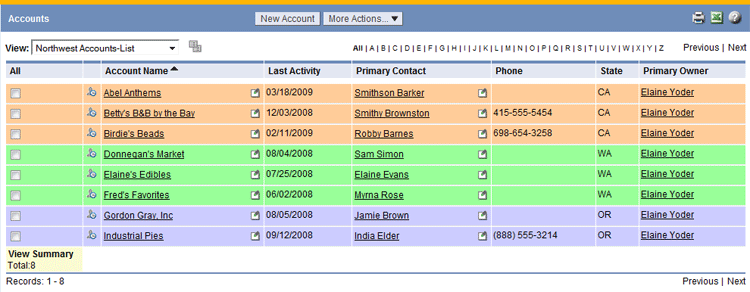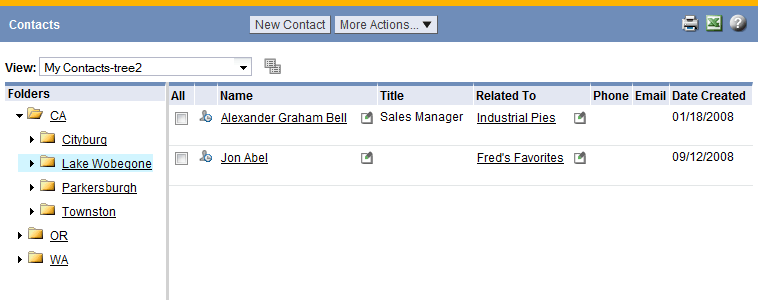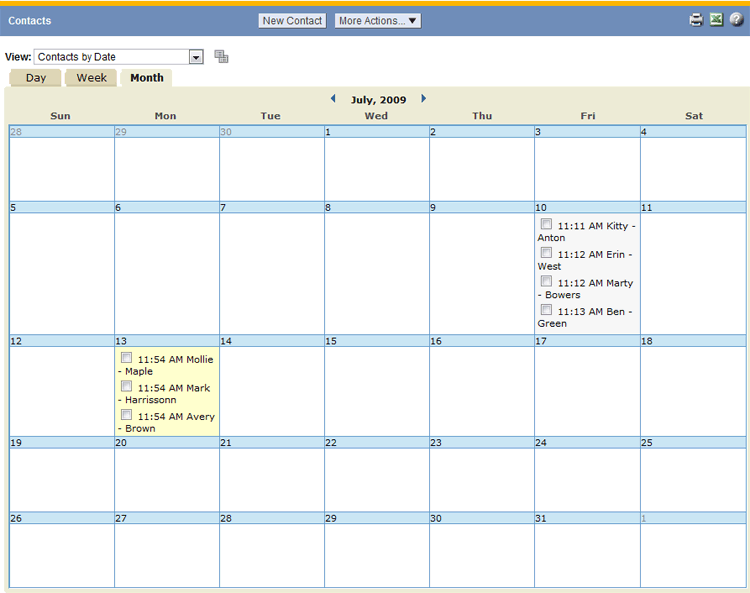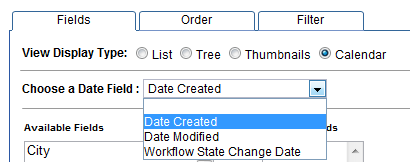Views
Workspace > {object} > Wrench icon ![]() > Edit this View
> Edit this View
A View displays a collection of objects. Views can be customized, saved with unique names, and made available to users with particular roles.
About Views
The default Object View displays all records in the Object. A custom View lets you determine which records are visible, which fields are displayed, and who can use that View. Such Views let you organize your data in a way that is meaningful, along with optional settings to customize and save views for reference or analysis.
With your data loaded into the platform, you can start creating custom views to convey specific information you want your team to see. By selecting the fields you want and assigning a variety of filters, you can isolate key information quickly and easily.
Users can define new views, so an entire team or a select group can share information. Multiple Views compartmentalize information about an object for quick access to records.
Views offer Visibility controls that grant view and edit rights to specific Users, Teams or Roles.
Most objects include Standard Views that are built into the platform.
When users create new views, the views are added to one of two sections, depending on the Visibility set when the view is saved:
- My Views - private views, visible only to the user that created the view
- Public Views - public views, visible to Users, Teams or Roles, as defined by the user that created the view
View Display Types
In addition to the (default) List Display, there are many more View Display Types you can use to organize records in an Object View:
-
- This is the default view display type
- Records are displayed as rows and columns in a table
-
- Optional, presents a sidebar with hierarchy tree to navigate to groups of records
-
- Optional, presents records in a calendar, based on a selected date field
Using a List View
The List or grid is the most common kind of multiple-record view, but there are other kinds of views as well. For example: Tree and Calendar displays. (Learn more: Views.)
In a List View, records are displayed in a grid, like a spreadsheet. At the top of the view, under the action buttons, a view control bar gives you many ways to control your view of the data:
- Choose from standard and custom Views to determine which records are selected and which information is displayed.
- Click the Wrench icon
 for a list of options you can use for Managing the View.
for a list of options you can use for Managing the View.
- Click a column heading to sort the records on that column.
(The column icon changes to show that it has been sorted.) - Click again to reverse the sort.
- Click an entry in the Alphabetic Index to limit the list to values starting with that letter in the most recently selected column.
- Type in a value and click the Magnifier icon
 to search for a record with that value. Click the down arrow to get a list of things you've searched on before.
to search for a record with that value. Click the down arrow to get a list of things you've searched on before. - Click the double down arrow icon
 to do advanced filtering:
to do advanced filtering:
- Things to know about filtering
- To apply a filter to a checkbox, use "1" for Yes/True and "0" for No/False values.
- Specify multiple values using the pipe "|" character. For example: "State equals CA|NY|MN"
- Specify an empty numeric field using BLANK. For example: "Phone equals BLANK"
- Specify an empty string field using two single-quotes with nothing between them: ('')
- Learn more:Complex Expressions
Note: The filter is not saved with the view. For details on how to include a filter in a View and save it for future use, see Filters.
Learn more: Working with a List View
Managing Views
View Options
Use the Wrench icon to customize the current view or build new views for you and your team.
- Edit this View - Make changes to the current view
- New View - Create a new View of this Object
- Delete this View - Delete the view, putting it into the Recycle Bin
- Make this My Default View - Use this View whenever you visit this object
- Print this View - Generate an HTML you can print or download from your browser.
- Export to Excel - Generate an Excel file you can open or download from your browser.
- Display Record Counts - Display the number of records in the current view and total the number of records stored in the database for this object.
Note: If your view of an Object has limits, the Record Count dialog displays the number of records you have permission to view, as well as the total number of records in the database.
- Learn more: Data Access Permissions.
Edit this View
Although users can edit both Standard Views and My Views, it is strongly recommended that Standard Views not be changed. If necessary, save the Standard View with a new name, and make the changes there.
Learn more: View Types
Users that have the Create/Delete Views/Reports/Homepages permission can edit Standard Views
To edit a view:
- Open any object
- Select a View
- Click the Wrench icon
 and select Edit this View
and select Edit this View - Specify View Settings
- Click the [Save] button to save the view
Or enter a new name and click [Save As] to save the view under a new name. - Choose Visibility options and click [Save]
The custom view becomes the current view, and it appears as an option in the View list.
New View
To create a New View:
- Open any object
- Select a View
- Click the Wrench icon
 and select New View
and select New View - Specify View Settings
- Click the [Save] button to save the view
Or enter a new name and click [Save As] to save the view under a new name. - Choose Visibility options and click [Save]
The custom view becomes the current view, and it appears as an option in the View list.
View Settings
When editing a view or creating a new one:
- In the Fields tab, choose the View Display Type
- Select the fields to include in the view (each selected field becomes available in the resulting view)
- Optionally, create Computed Fields
- In the Order tab, change the column order for the view; Select a field and use the up/down arrows to change the order
- Optionally, select the sort criteria for up to two fields, and choose Ascending or Descending order for each
- Optionally, set individual column widths by unchecking the Shrink Columns to Fit checkbox and clicking the Set Column Width link.
- In the Filter tab, restrict the population by ownership, date or field criteria:
Note: Several action buttons are available during this process:
- [Preview] - display the view before saving
(For the Calendar Display View Type, the preview option displays the records in a list - the actual view displays the data in a calendar format.) - [Previous] - move backward to the previous tab
- [Next] - move forward to the next tab
- [Preview] - display the view before saving
Other settings tabs depend on the kind of View you're working with. For example:
- In the Color Code tab, you can conditionally color-code rows based on field criteria.
(Not available for Thumbnail and Calendar views.) - In the Summary tab, you can select options to create computations on numeric fields.
(This tab only appears if the numeric values are visible in the View, and the view allows totals to be calculated.)
- In the Color Code tab, you can conditionally color-code rows based on field criteria.
Finally, each View has tabs that provide settings that are unique to that view. (Those tabs are explained below.)
List Display
In a List Display, records are displayed as rows and columns in a table.
- The List Display Type is selected from the Fields tab when creating or editing a View
- Learn More: View Options
- The List Display offers the following options to customize the view: Fields, Order, Filter, Color Code
Tree Display
In a Tree Display, a navigation sidebar displayed, which presents groups of records. Choose a folder in the sidebar to display groups of records as rows and columns in a table.
- Learn More: View Options
- The Tree Display offers the following options to customize the view: Fields, Order, Filter, Color Code, Group and Summary tabs
Calendar Display
In the Calendar Display, records are presented in a calendar, based on a selected date field. A typical use is in an Events Management application, to show deadlines or other critical dates in a calendar view.
- The Calendar Display Type is selected from the Fields tab when creating or editing a View
- Learn More: View Options
- The Record Identifier Fields are displayed in the calendar, along with the timestamp of the selected date field
- To change the information that is displayed in the calendar, modify the Record Identifier Fields in Record_Locators
- Note: The Record Identifier Fields are displayed in the heading bar of each record, so if these values are changed, it will be reflected throughout the platform
- The Calendar Display offers the following options to customize the view: Fields, Order, Filter.
Delete this View
You can delete any standard or custom views that you have created.
- Click the object tab associated with the view you want to delete.
The main page for that tab opens. - In the View list, select the name of the view you want to delete.
The view you selected becomes the current view. - In the View, select [Delete View].
A message appears, asking you to confirm the deletion of this view. - Click [OK]. The view is deleted from the View list.
Views, Reports and Object Inheritance
When creating Views or Reports in objects that are part of an Object Inheritance model, it is important to consider the following:
- A Report or View that has no Filters will return all records from the designated object, including records from all parent object(s) in the hierarchy (following the path up to the root level).
To restrict the View or Report to only the desired objects, include the Object Name field in the Selected Fields list, and create a Filter on Object Name field to select only the objects of interest.







